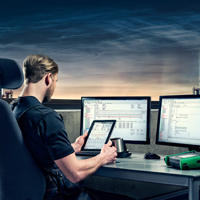 An Efficient Calibration Process Is Automated And Paperless
An Efficient Calibration Process Is Automated And Paperless
Every plant has a process on site for performing and managing calibrations, but there can be many different types of calibration processes and they vary in terms of quality, efficiency and productiveness.
The calibration process starts from the planning and scheduling of the calibration work and includes performing of calibrations as well as documentation of results. An efficient calibration process saves time, (Read More)
automates procedures, is cost-efficient and assures that the results are reliable. The best-in-class calibration processes are integrated, automated and paperless. This is the key message in Beamex’s global “Calibrations under Control” marketing campaign. Jan-Henrik Svensson, VP Marketing & Sales of Beamex Group explains, “We are not just offering a product or even a set of products and services – what we are actually offering is a new process of performing and managing calibrations in a way that provides efficiency and quality improvements as well as cost-savings”.
Beamex ICS, the integrated calibration solution, which constitutes the heart of this marketing campaign, is unique compared to any other calibration system due to its seamless communication between calibrators and calibration software, the possibility to integrate it into a maintenance management system (ERP/CMMS), the multifunctional calibrators that can perform automated calibrations fast and efficiently as well as the calibration software that allows smart analysis and management of all calibration data.
Improved Workflow
With paper-based systems, paper records that need approval have to be routed to several individuals, which is time-consuming. With Integrated calibration solutions the workflow improves dramatically. There will be less waiting time, as those individuals who need to sign off records or calibration documents can share or access electronic records simultaneously from a central database. The cost and time associated with printing copies of paper documents is also eliminated, as well as the cost of filing and storing those paper records.
Just as important, electronic records enable easier analysis of data, particularly calibration results. Historical trending becomes easier, faster and more reliable, which again has cost reduction benefits to the business. Calibration intervals can be optimised. For example, those instruments that are performing better than expected may well justify a reduction in their calibration frequency.
When a plant is being audited, calibration software facilitates both the preparation and the audit itself. Locating records and verifying that the system works becomes effortless when compared to traditional paper-based record keeping. Paperless calibration systems improve plant efficiencies because the entire calibration process is now streamlined and automated. Costly production downtime due to unforeseen instrument failures will also be reduced.
The microsite beamex.com/calibrationsundercontrol explains the benefits of an automated and paperless calibration process as well as includes an online test for testing the efficiency of a plant’s current calibration process.
BEAMEX is a leading, worldwide provider of calibration solutions that meet even the most demanding requirements of process instrumentation. For more information, visit www.beamex.com.

